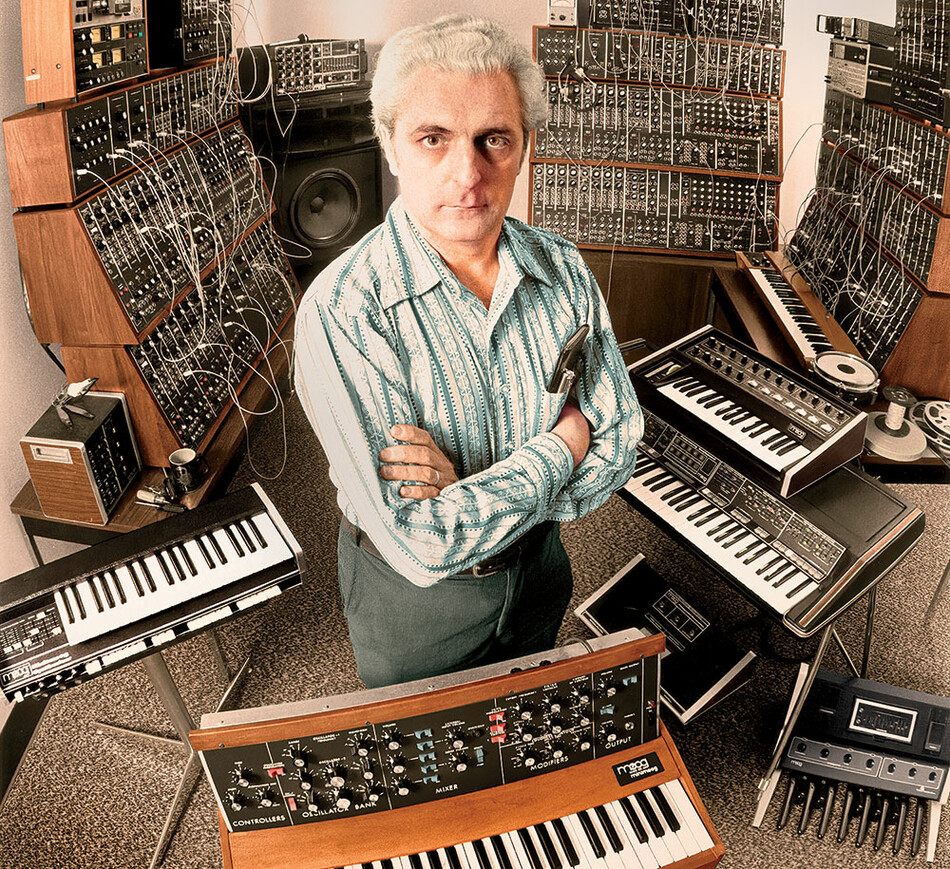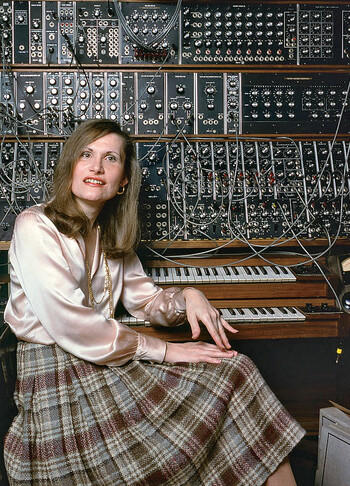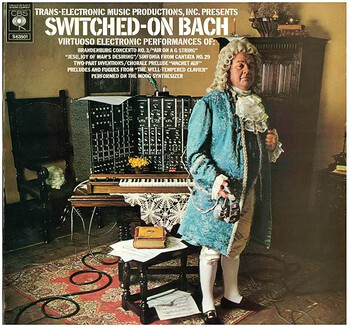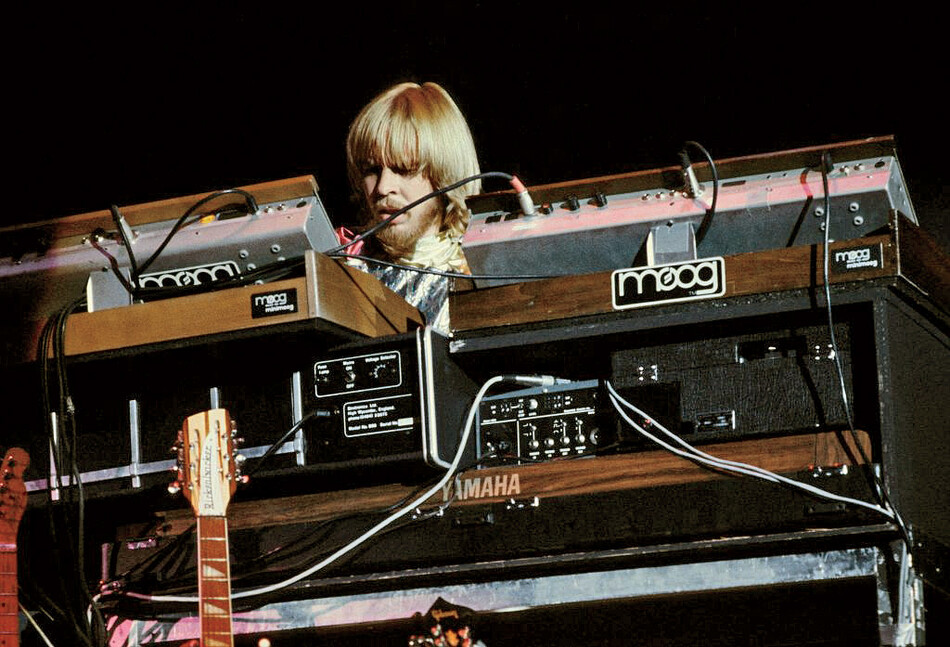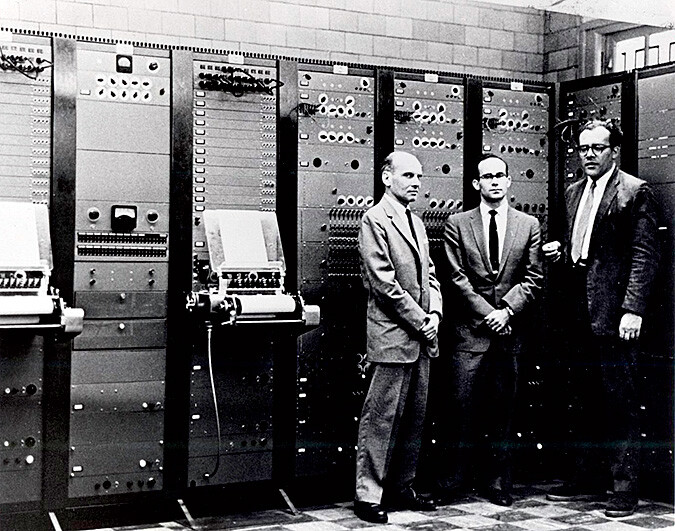How Robert Moog Launched Music into the Electronic Age
In October 1964, the month that the Soviet Union launched three cosmonauts into space and the Beatles played on ABC’s Shindig!, the Audio Engineering Society (AES) held its annual convention at New York’s Barbizon-Plaza Hotel. Anyone strolling the exhibits then would have noticed, among the latest microphones and tape-recording equipment from manufacturers like Ampex and Scully, a small booth displaying a curious-looking homemade contraption: a forty-four-key musical keyboard and four metal-paneled boxes, each about the size of a Whitman’s Sampler. The boxes had knobs and jacks and were connected to the keyboard and to each other with cables. A sign above the booth read: R. A. MOOG CO.
Behind the table stood Robert Moog ’57SEAS, a humble, good-humored, thirty-year-old electronics guru dressed in a white shirt and dark jacket. When the convention-goers — musicians, audiophiles, sound designers, retailers — stopped by, Moog (rhymes with rogue) invited them to put on a pair of headphones. Then, fiddling with a few knobs and pressing a few keys, he dialed up a series of idiosyncratic electronic sounds.
“People were fascinated,” says biographer Albert Glinsky, author of Switched On: Bob Moog and the Synthesizer Revolution. “At the time, the idea that you could take these little boxes, or modules, and make everything from static to siren sounds to musical tones to percussion sounds — it was a revelation.”
The term “synthesizer” first gained public attention in 1955, when the Radio Corporation of America unveiled the RCA Mark I Sound Synthesizer, which weighed more than an automobile. The Mark I used electronic circuits to generate sounds that could then be modified, and so did Moog’s prototype, which he jokingly called the Abominatron. But that’s where the similarities ended. “Bob’s synthesizer had a musical keyboard and was a much smaller, much more efficient instrument,” Glinsky says. While the Mark I and its successor, the Mark II, required hundreds of bulky vacuum tubes to control the flow of electrical current, Moog utilized the newer technology of transistors — tiny semiconductors that enabled smaller and lighter TVs, radios, and computers. Moog could fit the Abominatron in the trunk of his car.
At the AES convention, Moog explained his basic setup to visitors. His four modules housed two oscillators (vibrating components that produce basic sound waves), an amplifier (a device that boosts the audio signal, making the sound louder), and an envelope generator (a component that controls the timbre of the sound). “The genius of what Bob came up with,” says Glinsky, “is that the individual modules could be connected to each other with patch cords. That meant you could get one module to act upon another, to alter the shape and color of a sound in endless ways.”
As Moog once observed, “That’s the way a musician thinks of a synthesizer: this part changes the tone color, this part changes the pitches, this part changes the articulation. So when a musician works with patch cords and sets the knobs, he is synthesizing a sound.”
But in 1964, no one was synthesizing anything, at least not outside the world of avant-garde music. Indeed, Moog had conceived of his invention as a tool for experimental composers. That summer, he worked with composer Herbert Deutsch to come up with new sounds that Deutsch could use in his compositions. Deutsch would use his voice to approximate what he wanted, and Moog would then translate these utterances into the language of electronics. “For Bob, understanding what the musician needed out of the equipment was a crucial part of the process,” Glinsky says.
In the course of developing the instrument, Moog hacked the keyboard off an electronic organ and hooked it up to his modules, engineering things so that each key, when pressed, caused the oscillator to vibrate at the proper pitch. This allowed the Abominatron to play notes and melodies, but Moog wasn’t so interested in that. For him, the keyboard’s primary purpose was to trigger the sorts of new noises that Deutsch was after — blips and beeps and alien cries.
“At the time,” Deutsch later recalled, “I was actually still thinking primarily as a composer, and at first we were probably more interested in the potential expansion of the musical aural universe than we were in its effect upon the broader musical community.”
For that reason, Moog was reluctant to include the keyboard in his prototype. There was some debate. On the one hand, a keyboard would turn off experimental composers — Moog’s natural constituency — who were trying to escape the conventions of twelve-tone musicality that a keyboard implied. On the other hand, a keyboard-driven instrument would appeal to everyday musicians, making it far more feasible commercially. The second argument won out.
Still, Moog could hardly have imagined that his little synthesizer would transform the music industry. He was leading a quiet life in Trumansburg, New York, near Ithaca, with his wife and two daughters. By day he ran a small factory on Main Street, the R. A. Moog Company, which made kits for an electronic instrument called the theremin. Patented in 1928 by Russian inventor Leon Theremin, the device used two antennae to create electromagnetic fields that, at the wave of a hand, produced a high, quivery, voice-like tone, a sound popularized by 1950s sci-fi movies. Moog loved the simplicity and elegance of the theremin — he assembled his first one at age fourteen — and could have happily built them for the rest of his life.
Moog had always been a tinkerer. He grew up in Flushing, Queens, an only child whose mother wanted him to become a concert pianist. He took piano lessons but preferred fooling around with resistors and capacitors in his father’s basement workshop. It was the era of the electronics hobbyist — parts were plentiful and cheap following World War II — and while other kids played baseball, Moog was inside, downstairs, soldering circuits.
He graduated from the Bronx High School of Science and was accepted to Columbia to study electrical engineering. Going to Columbia meant he could commute from Queens, and it also deepened his connection with his favorite relative, the biologist Florence Moog ’44GSAS, his father’s sister, who'd earned her PhD in Morningside Heights.
“My dad and Aunt Florence were kindred spirits,” says Moog’s daughter Michelle Moog-Koussa. “They shared the same sensibilities and were both science-minded. Florence was as big an influence on my dad as Leon Theremin.” In one letter to his aunt, who taught for more than forty years at Washington University in St. Louis, Moog wrote, “The subways bother me less than I thought they would. I have developed the skill of using a slide-rule in the train, and therefore am able to solve problems while traveling.”
He also developed the engineering skills that would drive the design of his synthesizer. Moog graduated from the School of Engineering and Applied Science the same year the Soviet Union launched Sputnik, the first artificial satellite, into Earth’s orbit. The space race was on, technology became a geopolitical and cultural battlefront, and machines began merging with art in new ways: animator John Whitney made the first computer-animated film, Catalog, in 1961; artist Robert Rauschenberg worked with Bell Laboratories engineer Billy Klüver on the sound sculpture Oracle (1962–65); and at the Columbia-Princeton Electronic Music Center (now Columbia’s Computer Music Center), composers Vladimir Ussachevsky and Otto Luening were exploring new galaxies of sound with the RCA Mark II, a seven-foot-high, twenty-foot-long, three-ton behemoth residing in Columbia’s Prentis Hall (see sidebar on p. 36).
It was in this tech-centric atmosphere that Moog stood behind his table at the AES convention. The Abominatron drew a lot of oohs and ahhs, and Moog returned to the convention the following year. He met a number of tech-curious artists during this period, but there was one who took a particularly vivid interest in Moog’s display. This was Wendy Carlos ’65GSAS. The meeting between Moog and Carlos would trigger the synthesizer revolution.
Carlos is eighty-five and no longer speaks to the press. An award-winning composer who scored the films A Clockwork Orange and The Shining, Carlos has left a gold mine of writings on her website. In her telling, it was Professor Ussachevsky who, aware of Carlos’s technical acumen (Carlos had worked with the Mark II at Columbia), urged her to check out the AES convention.
Inside the Barbizon-Plaza, Carlos spotted Moog’s booth and went over to have a look at the modules. She lit up at the sight. “There they were,” she writes. “Voltage-controlled oscillators, filters, envelopers, controllers — things the still primitive world of electroacoustic music long needed!” Carlos and Moog connected instantly. As Carlos recalls, “It was a perfect fit: he was a creative engineer who spoke music; I was a musician who spoke science. It felt like a meeting of simpatico minds.”
Carlos became one of Moog’s earliest customers, and by the time the first generation of Moog synthesizers hit the market in 1967, Carlos and Moog were collaborating. Carlos’s graduate work with the Mark II had been modern and experimental, but she had a whole other concept for the Moog synthesizer: she wanted to use it to play the music of Johann Sebastian Bach.
Classical-music purists would surely cry blasphemy, but Carlos and Moog were on a mission. Carlos asked for modifications to some of the modules, and, to Moog’s amazement, she quickly mastered the controls. “I’d only seen a very few people who took so naturally to an instrument as she did to the synthesizer,” Moog later said. “It was just a God-given gift.”
“Bob always deferred on musical matters to those of us who came from that side of the art/tech equation,” writes Carlos. “We, on the other hand, deferred to Bob on all engineering decisions and designs. From the beginning it was a balanced yin/yang relationship between a maker of musical tools and the artists who used those tools.”
Carlos made a tape of Bach pieces that she played on her custom-built Moog system and gave it to her friend Rachel Elkind, who was the assistant to the president of Columbia Records. The tape was sonic dynamite, and Elkind sold the idea of an electronic Bach album to her colleagues and produced the album.
“Up until that time, to the average person, electronic music was associated with bleeps and noise and sound effects,” says Glinsky. “Nobody thought it would be playing Bach. The idea that electronic musical instruments could generate sounds that were slightly familiar, like strings and winds and brass, with entirely new timbres, was astonishing. It was a year before the moon landing, the drug culture was big, and so the idea of this sort of psychedelic Bach being played electronically really captured people’s imaginations.”
Carlos’s 1968 album Switched-On Bach, created entirely with the Moog, became the first million-selling classical album in history and won three Grammy Awards. “Bob had no idea that it was going to sell the way it did,” says Glinsky. Carlos called it “something that happens every so often in history … a magical moment when the timing is right.”
Switched-On Bach launched the Moog sound into the cultural consciousness. In July 1969, CBS News used composer Mort Garson’s Moog-generated textures to accompany its coverage of the Apollo 11 moon landing, and in August, at EMI Studios in London, the Beatles absorbed the instrument into their last-recorded album, Abbey Road.
Then, in 1970, Moog introduced the Minimoog, a forty-four-key monophonic instrument (meaning it can play just one note at a time) in which the modules were connected under a single panel. Designed for performance, the Minimoog could produce a plethora of sounds, including the bright, bulbous, buzzy tone that became the Moog signature. It had switches instead of patch cords and a pitch wheel that allowed you to bend notes, guitar-like. This created a new hero, the keyboardist, who possessed a magical musical weapon and was emboldened to play epic solos. Rick Wakeman, keyboardist for Yes, told Moog that the Minimoog “changed the face of music, and I bow to you forever for that.” And synth-pop pioneer Gary Numan, who used Moog synths for his entire minimalist, futuristic sound, once recalled the room-shaking sensation he felt the first time he touched the Minimoog: “That’s like ten guitar players at full power — on one finger!”
Through the 1970s, Moog synthesizers would shape progressive rock (Emerson, Lake & Palmer), electronica (Tangerine Dream, Kraftwerk), jazz fusion (Chick Corea, Herbie Hancock), funk (think Bernie Worrell’s fat Moog bass line on Parliament’s “Flash Light”), techno, disco, new wave (Numan’s “Cars”), commercial jingles, TV-show themes (The Price Is Right and ABC World News Tonight, by Edd Kalehoff), movie soundtracks (Apocalypse Now), and more.
None of this changed Bob Moog. Even when his name became synonymous with the synthesizer, he was still the same guy, the unassuming circuitry nerd with his pocket protectors and pens, in tune with the forces that he harnessed in his work. “I can feel what’s going on inside a piece of electronic equipment,” Moog once said. “I have this sense that I know, and to some extent I have control over, what’s going on inside the transistors.”
For Moog, electricity — the flow of electrons from one atom to another — had a spiritual power. “My father was just connected to the universe in a different way than anyone else,” says Moog-Koussa. “He was on another plane.”
Yet for all his brilliance, Moog always saw himself as nothing more, and nothing less, than a toolmaker to musicians — to him, the most honorable of callings and a testament to his grounded sense of self. “Bob was one of the most real, down-to-earth, genuine people I’ve ever met,” says Glinsky. “He had a wonderful sense of humor, and he didn’t put on airs. Even though he became quite famous, he still treated you like he was your best friend.”
Though his synthesizers were soon everywhere, Moog struggled financially. His genial nature and idealism were often at odds with the bottom line. “He was always just one step away from bankruptcy, and sometimes even in bankruptcy,” Glinsky says. “He was a great inventor, but he was not a good businessman — and who would expect him to be?”
Things got so bad that Moog had to sell the business in 1971, even as the Minimoog boomed. He stayed with the company — called Moog Music — as a designer and in 1978, after his contract was up, moved to rural North Carolina, where he started another company called Big Briar (he couldn’t use his own name, which had been bought along with the business). His property covered nearly a hundred acres of wood, field, and stream outside Asheville. Moog built a metal shed for a workshop and continued to manufacture his gadgets, including a new generation of theremins. “He loved it,” says Glinsky. “Going to work just meant walking across his driveway into the shed.”
Meanwhile, the synth industry was undergoing a sea change. Digital technology, cheaper and more versatile, was replacing the analog technology of Moog’s synthesizers. Whereas Moog’s equipment used electronic circuitry and oscillators to create a continuous sound wave, the digital synthesizers created sound waves from binary code. The difference this made in sound quality is roughly comparable to the difference between film photography and digital photography: the former is thought to be “warmer,” the latter, more precise and consistent. With the sleek new digital synthesizers taking over, Moog Music — Moog’s old company — filed for bankruptcy in 1987.
But given the fluidity of fashion and taste, it was only a matter of time before digital musicians started getting nostalgic for the authentic imperfections, character, and hands-on control of analog synthesizers. The inevitable digital backlash of the 1990s and early 2000s accrued favorably to Moog. In 2002, the Moog name reverted back to him: he rebranded Big Briar as Moog Music, then entered into a partnership with entrepreneur Mike Adams.
“Mike tidied up the business and started to turn a real profit,” Glinsky says. “And Bob was very moved by that. In the last three years of his life he was able to see that his products were still viable and could make money. That was a wonderful thing for him.”
So was living in the country: Moog became an avid gardener and devotee of nature. He designed and built instruments and grew organic vegetables. “I loved the perfectly apt image he took on during his last ten years, sort of a benevolent, wise old Swiss Watchmaker,” writes Carlos. “Those knowing hands of his were always a pleasure to see in action.”
There was, and still is, a misconception that Moog invented the synthesizer. “He invented the Moog synthesizer,” says Moog-Koussa. “That’s a very different thing.” In the “Moogseum” in downtown Asheville, an interactive museum run by the Bob Moog Foundation, a “timeline of synthesis” honors thirty-four different developments over a hundred-year period, starting with Thaddeus Cahill’s telharmonium in 1897. Three of Moog’s instruments fall in the middle. “He saw himself as part of a continuum,” Moog-Koussa says.
Moog died of brain cancer in 2005 at age seventy-one. Carlos went down to Asheville to speak at his memorial, where she honored him as “an intelligent, modest, and lovable man, who helped us define a new medium.”
That new medium reached listeners in all sorts of ways. Maybe you first noticed it in that storm of white noise at the end of the Beatles’ “I Want You (She’s So Heavy),” or in the baroque carnival of Switched-On Bach, or in the electric dance-floor pulse of Donna Summer’s “I Feel Love.” Or maybe you were cruising the FM dial in the car one day when the 1970 ballad “Lucky Man” by Emerson, Lake & Palmer came on: you listened to the lull and lilt of the strumming acoustic guitar, when suddenly, toward the end, a deep vibration began buzzing beneath the nylon-string fabric and burst forth, bright and bold. That classic Moog sound, electricity’s raw voice, soaring above the song and bending in space, announced to all that the future had arrived.
The Synth that Ate Manhattan
in 1957, RCA introduced the Mark II Sound Synthesizer. Like a player piano, the machine read hole-punched paper rolls to produce all manner of sounds. RCA’s hope was that the Mark II could replace live musicians in its radio stations’ unionized orchestras.
But the three-ton instrument, housed at the RCA Laboratories in New Jersey, proved too big and complicated for commercial use. Meanwhile, in 1958, a clique of avant-garde composers — Vladimir Ussachevsky and Otto Luening at Columbia and Milton Babbitt and Roger Sessions at Princeton — formed the Columbia-Princeton Electronic Music Center. One of their first moves was to acquire the Mark II, which was installed in Prentis Hall on W. 125th Street in 1959.
Babbitt was its most frequent operator. Wendy Carlos used it, and in 1970, Charles Wuorinen ’61CC, ’63GSAS received the Pulitzer Prize for Time’s Encomium, created entirely on the Mark II — the first fully electronic composition to win the award. But the giant device was not long for a fast-changing world. The Mark II beeped its last beeps in 1997 and remains in Prentis Hall to this day.
Bob Moog, for one, never believed that his synths would replace musicians. “To me,” he once said, “the synthesizer was always a source of new sounds that musicians could use to expand the range of possibilities for making music.” The old Mark II composers might agree.
